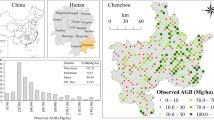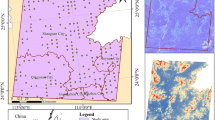Abstract
Accurate estimates of forest aboveground biomass (AGB) are critical for supporting strategies of ecosystem conservation and climate change mitigation. The Jiuzhaigou National Nature Reserve, located in Eastern Tibet Plateau, has rich forest resources on steep slopes and is very sensitive to climate change but plays an important role in the regulation of regional carbon cycles. However, an estimation of AGB of subalpine forests in the Nature Reserve has not been carried out and whether a global biomass model is available has not been determined. To provide this information, Landsat 8 OLI and Sentinel-2B data were combined to estimate subalpine forest AGB using linear regression, and two machine learning approaches–random forest and extreme gradient boosting, with 54 inventory plots. Regardless of forest type, Observed AGB of the Reserve varied from 61.7 to 475.1 Mg ha−1 with an average of 180.6 Mg ha−1. Results indicate that integrating the Landsat 8 OLI and Sentinel-2B imagery significantly improved model efficiency regardless of modelling approaches. The results highlight a potential way to improve the prediction of forest AGB in mountainous regions. Modelled AGB indicated a strong spatial variability. However, the modelled biomass varied greatly with global biomass products, indicating that global biomass products should be evaluated in regional AGB estimates and more field observations are required, particularly for areas with complex terrain to improve model accuracy.







Similar content being viewed by others
References
Adam E, Mutanga O, Rugege D (2010) Multispectral and hyperspectral remote sensing for identification and mapping of wetland vegetation: a review. Wetl Ecol Manag 18(3):281–296
Ali I, Greifeneder F, Stamenkovic J, Neumann M, Notarnicola C (2015) Review of machine learning approaches for biomass and soil moisture retrievals from remote sensing data. Remote Sens 7(12):16398–16421
Barbosa JM, Broadbent EN, Bitencourt MD (2014) Remote sensing of aboveground biomass in tropical secondary forests: a Review. Int J for Res 2014:1–14
Beer C, Reichstein M, Tomelleri E, Ciais P, Jung M, Carvalhais N, Rodenbeck C, Arain MA, Baldocchi D, Bonan GB, Bondeau A, Cescatti A, Lasslop G, Lindroth A, Lomas M, Luyssaert S, Margolis H, Oleson KW, Roupsard O, Veenendaal E, Viovy N, Williams C, Woodward FI, Papale D (2010) Terrestrial gross carbon dioxide uptake: global distribution and covariation with climate. Science 329(5993):834–838
Blackard JA, Finco MV, Helmer EH, Holden GR, Hoppus ML, Jacobs DM, Lister AJ, Moisen GG, Nelson MD, Riemann R (2008) Mapping US forest biomass using nationwide forest inventory data and moderate resolution information. Remote Sens Environ 112(4):1658–1677
Bossard CC, Cao YT, Wang JY, Rose A, Tang Y (2015) New patterns of establishment and growth of Picea, Abies and Betula tree species in subalpine forest gaps of Jiuzhaigou National Nature Reserve, Sichuan, southwestern China in a changing environment. For Ecol Manag 356:84–92
Breiman L (2001) Random forests. Mach Learn 45(1):5–32
Carreiras JMB, Vasconcelos MJ, Lucas RM (2012) Understanding the relationship between aboveground biomass and ALOS PALSAR data in the forests of Guinea-Bissau (West Africa). Remote Sens Environ 121:426–442
Chen TQ, Guestrin C (2016) Xgboost: A scalable tree boosting system. KDD '16 In: Proceedings of the 22nd ACM SIGKDD International Conference on Knowledge Discovery and Data Mining. https://doi.org/10.1145/2939672.2939785
Cutler MEJ, Boyd DS, Foody GM, Vetrivel A (2012) Estimating tropical forest biomass with a combination of SAR image texture and Landsat TM data: an assessment of predictions between regions. ISPRS J Photogramm Remote Sens 70:66–77
de Almeida CT, Galvao LS, de Oliveira Cruz e Aragao LE, Henry Balbaud Ometto JP, Jacon AD, de Souza Pereira FR, Sato LY, Lopes AP, de Alencastro L, Graca PM, Silva CVJ, Ferreira-Ferreira J, Longo M (2019) Combining LiDAR and hyperspectral data for aboveground biomass modeling in the Brazilian Amazon using different regression algorithms. Remote Sens Environ 232:111323
Dube T, Mutanga O (2015) Evaluating the utility of the medium-spatial resolution Landsat 8 multispectral sensor in quantifying aboveground biomass in uMgeni catchment, South Africa. ISPRS J Photogramm Remote Sens 101:36–46
FAO (2015) Global forest resources assessment 2015. UN Food and Agriculture Organization, Rome, pp 3–244
Farrar DE, Glauber RR (1967) Multicollinearity in regression analysis: the problem revisited. Rev Econ Stat 49(1):92–107
Fonseca TF, Marques CP (2011) Carbon stock assessment at a regional level, on pure and mixed stands, based on inventory data: a case study. Open j for (online) 1(1):6
Forkuor G, Dimobe K, Serme I, Tondoh JE (2018) Landsat-8 vs. Sentinel-2: examining the added value of sentinel-2’s red-edge bands to land-use and land-cover mapping in Burkina Faso. GIsci Remote Sens 55(3):331–354
Friedman JH (2002) Stochastic gradient boosting. Comput Stat Data Anal 38(4):367–378
Fushiki T (2011) Estimation of prediction error by using K-fold cross-validation. Stat Comput 21(2):137–146
Guyon I, Weston J, Barnhill S, Vapnik V (2002) Gene selection for cancer classification using support vector machines. Mach Learn 46(1–3):389–422
Haboudane D, Miller JR, Pattey E, Zarco-Tejada PJ, Strachan IB (2004) Hyperspectral vegetation indices and novel algorithms for predicting green LAI of crop canopies: modeling and validation in the context of precision agriculture. Remote Sens Environ 90(3):337–352
Hanes J (2013) Biophysical applications of satellite remote sensing. Springer, Berlin, pp 2–30
Haralick RM (1979) Statistical and structural approaches to texture. Proc IEEE Inst Electr Electron Eng 67(5):786–804
Haralick RM, Shanmugam K, Dinstein IH (1973) Textural features for image classification. IEEE Trans Syst Man Cybern SMC-3(6):610–621
He HL, Zhang WY, Zhang S (2018) A novel ensemble method for credit scoring: adaption of different imbalance ratios. Expert Syst Appl 98:105–117
James G, Witten D, Hastie T, Tibshirani R (2013) An introduction to statistical learning. Springer, New York, pp 80–426
Korhonen L, Packalen P, Rautiainen M (2017) Comparison of Sentinel-2 and Landsat 8 in the estimation of boreal forest canopy cover and leaf area index. Remote Sens Environ 195:259–274
Li WJ, Ge XD, Liu CY (2005) Hiking trails and tourism impact assessment in protected area: Jiuzhaigou biosphere reserve. China Environ Monit Assess 108(1–3):279–293
Li Y, Li M, Li C, Liu Z (2020) Forest aboveground biomass estimation using landsat 8 and sentinel-1A data with machine learning algorithms. Sci Rep 10(1):9952
Liang SL (2007) Recent developments in estimating land surface biogeophysical variables from optical remote sensing. Prog Phys Geogr 31(5):501–516
López-Serrano PM, Cárdenas Domínguez JL, Corral-Rivas JJ, Jiménez E, López-Sánchez CA, Vega-Nieva DJ (2020) Modeling of aboveground biomass with landsat 8 OLI and machine learning in temperate forests. Forests 11(1):11
Lu DS, Chen Q, Wang GX, Liu LJ, Li GY, Moran E (2014) A survey of remote sensing-based aboveground biomass estimation methods in forest ecosystems. Int J Digit Earth 9(1):63–105
Mansfield ER, Helms BP (1982) Detecting multicollinearity. Am Stat 36(3a):158–160
Mohd Zaki NA, Abd LZ (2016) Carbon sinks and tropical forest biomass estimation: a review on role of remote sensing in aboveground-biomass modelling. Geocarto Int 32(7):701–716. https://doi.org/10.1080/10106049.2016.1178814
Monnet JM, Chanussot J, Berger F (2011) Support vector regression for the estimation of forest stand parameters using airborne laser scanning. IEEE Geosci Remote Sens Lett 8(3):580–584
Nelson R, Ranson KJ, Sun G, Kimes DS, Kharuk V, Montesano P (2009) Estimating Siberian timber volume using MODIS and ICESat/GLAS. Remote Sens Environ 113(3):691–701
Pan YD, Birdsey RA, Phillips OL, Jackson RB (2013) The structure, distribution, and biomass of the world’s forests. Annu Rev Ecol Evol Syst 44(1):593–622
Pandit S, Tsuyuki S, Dube T (2018) Estimating above-ground biomass in sub-tropical buffer zone community forests, Nepal, using sentinel 2 data. Remote Sens 10(4):601
Powell SL, Cohen WB, Healey SP, Kennedy RE, Moisen GG, Pierce KB, Ohmann JL (2010) Quantification of live aboveground forest biomass dynamics with landsat time-series and field inventory data: a comparison of empirical modeling approaches. Remote Sens Environ 114(5):1053–1068
Qureshi A, Badola R, Hussain SA (2012) A review of protocols used for assessment of carbon stock in forested landscapes. Environ Sci Policy 16:81–89
Reichstein M, Carvalhais N (2019) Aspects of forest biomass in the earth system: its role and major unknowns. Surv Geophys 40(4):693–707
Rodríguez-Veiga P, Saatchi S, Tansey K, Balzter H (2016) Magnitude, spatial distribution and uncertainty of forest biomass stocks in Mexico. Remote Sens Environ 183:265–281
Roy DP, Huang HY, Boschetti L, Giglio L, Yan L, Zhang HH, Li ZB (2019) Landsat-8 and sentinel-2 burned area mapping - a combined sensor multi-temporal change detection approach. Remote Sens Environ 231:111254
Santoro M, Cartus O (2019) ESA biomass climate change initiative (Biomass_cci): global datasets of forest above-ground biomass for the year 2017, v1. Centre for Environ Data Analysis. https://doi.org/10.5285/bedc59f37c9545c981a839eb552e4084
Shen WJ, Li MS, Huang CQ, Wei AS (2016) Quantifying live aboveground biomass and forest disturbance of mountainous natural and plantation forests in Northern Guangdong, China, based on multi-temporal landsat, PALSAR and field plot data. Remote Sens 8(7):595
Sibanda M, Mutanga O, Rouget M (2015) Examining the potential of sentinel-2 MSI spectral resolution in quantifying above ground biomass across different fertilizer treatments. ISPRS J Photogramm Remote Sens 110:55–65
Spawn SA, Sullivan CC, Lark TJ, Gibbs HK (2020) Harmonized global maps of above and belowground biomass carbon density in the year 2010. Sci Data. https://doi.org/10.1038/s41597-020-0444-4
Steininger MK (2000) Satellite estimation of tropical secondary forest above-ground biomass: data from Brazil and Bolivia. Int J Remote Sens 21(6–7):1139–1157
Stelmaszczuk-Górska MA, Rodriguez-Veiga P, Ackermann N, Thiel C, Balzter H, Schmullius C (2016) Non-parametric retrieval of aboveground biomass in Siberian Boreal Forests with ALOS PALSAR interferometric coherence and backscatter intensity. J Imaging 2(1):1
Su YJ, Guo QH, Xue BL, Hu TY, Alvarez O, Tao SL, Fang JY (2016) Spatial distribution of forest aboveground biomass in China: estimation through combination of spaceborne lidar, optical imagery, and forest inventory data. Remote Sens Environ 173:187–199
Tonolli S, Dalponte M, Neteler M, Rodeghiero M, Vescovo L, Gianelle D (2011) Fusion of airborne LiDAR and satellite multispectral data for the estimation of timber volume in the Southern Alps. Remote Sens Environ 115(10):2486–2498
Vafaei S, Soosani J, Adeli K, Fadaei H, Naghavi H, Pham T, Tien Bui D (2018) Improving accuracy estimation of forest aboveground biomass based on incorporation of ALOS-2 PALSAR-2 and sentinel-2A imagery and machine learning: a case study of the hyrcanian forest area (Iran). Remote Sens 10(2):172
Zhu XL, Liu DS (2015) Improving forest aboveground biomass estimation using seasonal Landsat NDVI time-series. ISPRS J Photogramm Remote Sens 102:222–231
Author information
Authors and Affiliations
Corresponding author
Additional information
Publisher's Note
Springer Nature remains neutral with regard to jurisdictional claims in published maps and institutional affiliations.
Project funding: This project was supported financially by the Specialized Fund for the Post-Disaster Reconstruction and Heritage Protec-tion in Sichuan Province (5132202019000128); the Everest Scientific Research Program of Chengdu University of Technology (80000-2021ZF11410); the Second Tibetan Plateau Scientific Expedition and Research Program (STEP, 2019QZKK0307); the State Key Laborato-ry of Geohazard Prevention and Geoenvironment Protection Independent Research Project (SKLGP2018Z004); the key technologies of Mountain rail transit green construction in ecologically sensitive region based on Mountain rail transit from Dujiangyan to Mt. Siguniang anti-poverty project (2018-zl-08); and, Study on risk identification and countermeasures of Sichuan-Tibet Railway Major Projects (2019YFG0460).
The online version is available at http://www.springerlink.com
Corresponding editor: Zhu Hong.
Supplementary Information
Below is the link to the electronic supplementary material.
Rights and permissions
About this article
Cite this article
Luo, K., Wei, Y., Du, J. et al. Machine learning-based estimates of aboveground biomass of subalpine forests using Landsat 8 OLI and Sentinel-2B images in the Jiuzhaigou National Nature Reserve, Eastern Tibet Plateau. J. For. Res. 33, 1329–1340 (2022). https://doi.org/10.1007/s11676-021-01421-w
Received:
Accepted:
Published:
Issue Date:
DOI: https://doi.org/10.1007/s11676-021-01421-w




